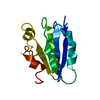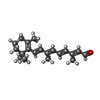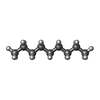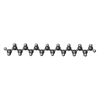[English] 日本語
 Yorodumi
Yorodumi- PDB-7zy3: Room temperature structure of Archaerhodopsin-3 obtained 110 ns a... -
+ Open data
Open data
- Basic information
Basic information
| Entry | Database: PDB / ID: 7zy3 | ||||||||||||
|---|---|---|---|---|---|---|---|---|---|---|---|---|---|
| Title | Room temperature structure of Archaerhodopsin-3 obtained 110 ns after photoexcitation | ||||||||||||
 Components Components | Archaerhodopsin-3 | ||||||||||||
 Keywords Keywords | PROTON TRANSPORT / Membrane protein / Proton tranport / Rhodopsin / Lipidic cubic phase / SFX | ||||||||||||
| Function / homology |  Function and homology information Function and homology informationmonoatomic ion channel activity / photoreceptor activity / phototransduction / proton transmembrane transport / plasma membrane Similarity search - Function | ||||||||||||
| Biological species |  Halorubrum sodomense (archaea) Halorubrum sodomense (archaea) | ||||||||||||
| Method |  X-RAY DIFFRACTION / X-RAY DIFFRACTION /  FREE ELECTRON LASER / FREE ELECTRON LASER /  MOLECULAR REPLACEMENT / Resolution: 1.8 Å MOLECULAR REPLACEMENT / Resolution: 1.8 Å | ||||||||||||
 Authors Authors | Kwan, T.O.C. / Judge, P.J. / Moraes, I. / Watts, A. / Axford, D. / Bada Juarez, J.F. | ||||||||||||
| Funding support |  United Kingdom, 3items United Kingdom, 3items
| ||||||||||||
 Citation Citation |  Journal: J.Appl.Crystallogr. / Year: 2023 Journal: J.Appl.Crystallogr. / Year: 2023Title: A versatile approach to high-density microcrystals in lipidic cubic phase for room-temperature serial crystallography. Authors: Birch, J. / Kwan, T.O.C. / Judge, P.J. / Axford, D. / Aller, P. / Butryn, A. / Reis, R.I. / Bada Juarez, J.F. / Vinals, J. / Owen, R.L. / Nango, E. / Tanaka, R. / Tono, K. / Joti, Y. / ...Authors: Birch, J. / Kwan, T.O.C. / Judge, P.J. / Axford, D. / Aller, P. / Butryn, A. / Reis, R.I. / Bada Juarez, J.F. / Vinals, J. / Owen, R.L. / Nango, E. / Tanaka, R. / Tono, K. / Joti, Y. / Tanaka, T. / Owada, S. / Sugahara, M. / Iwata, S. / Orville, A.M. / Watts, A. / Moraes, I. | ||||||||||||
| History |
|
- Structure visualization
Structure visualization
| Structure viewer | Molecule:  Molmil Molmil Jmol/JSmol Jmol/JSmol |
|---|
- Downloads & links
Downloads & links
- Download
Download
| PDBx/mmCIF format |  7zy3.cif.gz 7zy3.cif.gz | 112.9 KB | Display |  PDBx/mmCIF format PDBx/mmCIF format |
|---|---|---|---|---|
| PDB format |  pdb7zy3.ent.gz pdb7zy3.ent.gz | 86.8 KB | Display |  PDB format PDB format |
| PDBx/mmJSON format |  7zy3.json.gz 7zy3.json.gz | Tree view |  PDBx/mmJSON format PDBx/mmJSON format | |
| Others |  Other downloads Other downloads |
-Validation report
| Summary document |  7zy3_validation.pdf.gz 7zy3_validation.pdf.gz | 1.1 MB | Display |  wwPDB validaton report wwPDB validaton report |
|---|---|---|---|---|
| Full document |  7zy3_full_validation.pdf.gz 7zy3_full_validation.pdf.gz | 1.2 MB | Display | |
| Data in XML |  7zy3_validation.xml.gz 7zy3_validation.xml.gz | 13.1 KB | Display | |
| Data in CIF |  7zy3_validation.cif.gz 7zy3_validation.cif.gz | 17.3 KB | Display | |
| Arichive directory |  https://data.pdbj.org/pub/pdb/validation_reports/zy/7zy3 https://data.pdbj.org/pub/pdb/validation_reports/zy/7zy3 ftp://data.pdbj.org/pub/pdb/validation_reports/zy/7zy3 ftp://data.pdbj.org/pub/pdb/validation_reports/zy/7zy3 | HTTPS FTP |
-Related structure data
| Related structure data |  8a2oC  8a2pC  1auzS S: Starting model for refinement C: citing same article ( |
|---|---|
| Similar structure data | Similarity search - Function & homology  F&H Search F&H Search |
- Links
Links
- Assembly
Assembly
| Deposited unit | 
| ||||||||
|---|---|---|---|---|---|---|---|---|---|
| 1 |
| ||||||||
| Unit cell |
|
- Components
Components
-Protein , 1 types, 1 molecules A
| #1: Protein | Mass: 27102.613 Da / Num. of mol.: 1 / Source method: isolated from a natural source Details: The PCA residue needs to be in position 7 in the protein chain as the PCA is a modified glutamine residue, so Gln7 has become PCA. Source: (natural)  Halorubrum sodomense (archaea) / Variant: RD-26 / Tissue: MEMBRANE / References: UniProt: P96787 Halorubrum sodomense (archaea) / Variant: RD-26 / Tissue: MEMBRANE / References: UniProt: P96787 |
|---|
-Non-polymers , 9 types, 74 molecules 
















| #2: Chemical | ChemComp-RET / | ||||||||||
|---|---|---|---|---|---|---|---|---|---|---|---|
| #3: Chemical | ChemComp-DD9 / | ||||||||||
| #4: Chemical | ChemComp-R16 / | ||||||||||
| #5: Chemical | | #6: Chemical | ChemComp-CA / | #7: Chemical | ChemComp-NA / | #8: Chemical | ChemComp-MG / | #9: Chemical | #10: Water | ChemComp-HOH / | |
-Details
| Has ligand of interest | Y |
|---|---|
| Has protein modification | Y |
-Experimental details
-Experiment
| Experiment | Method:  X-RAY DIFFRACTION / Number of used crystals: 1 X-RAY DIFFRACTION / Number of used crystals: 1 |
|---|
- Sample preparation
Sample preparation
| Crystal | Density Matthews: 2.32 Å3/Da / Density % sol: 47 % / Description: Plates |
|---|---|
| Crystal grow | Temperature: 293 K / Method: lipidic cubic phase / pH: 5.5 Details: 33% v/v polyethylene glycol 600, 100 mM MES buffer pH 5.5, 150 mM NaCl and 150 mM CaCl2 |
-Data collection
| Diffraction | Mean temperature: 298 K / Serial crystal experiment: N |
|---|---|
| Diffraction source | Source:  FREE ELECTRON LASER / Site: FREE ELECTRON LASER / Site:  SACLA SACLA  / Beamline: BL2 / Wavelength: 1.23 Å / Beamline: BL2 / Wavelength: 1.23 Å |
| Detector | Type: MPCCD / Detector: CCD / Date: Jan 31, 2019 |
| Radiation | Monochromator: M / Protocol: SINGLE WAVELENGTH / Monochromatic (M) / Laue (L): M / Scattering type: x-ray |
| Radiation wavelength | Wavelength: 1.23 Å / Relative weight: 1 |
| Reflection | Resolution: 1.7→28.29 Å / Num. obs: 26515 / % possible obs: 100 % / Redundancy: 101.5 % / Biso Wilson estimate: 32.3 Å2 / CC1/2: 0.992 / Net I/σ(I): 3.79 |
| Reflection shell | Resolution: 1.7→1.72 Å / Redundancy: 65.2 % / Mean I/σ(I) obs: 0.59 / Num. unique obs: 1299 / R split: 1.82 / % possible all: 100 |
- Processing
Processing
| Software |
| |||||||||||||||||||||||||||||||||||||||||||||
|---|---|---|---|---|---|---|---|---|---|---|---|---|---|---|---|---|---|---|---|---|---|---|---|---|---|---|---|---|---|---|---|---|---|---|---|---|---|---|---|---|---|---|---|---|---|---|
| Refinement | Method to determine structure:  MOLECULAR REPLACEMENT MOLECULAR REPLACEMENTStarting model: 1AUZ Resolution: 1.8→28.149 Å / SU ML: 0.21 / Cross valid method: THROUGHOUT / σ(F): 1.36 / Phase error: 19.97 / Stereochemistry target values: ML
| |||||||||||||||||||||||||||||||||||||||||||||
| Solvent computation | Shrinkage radii: 0.9 Å / VDW probe radii: 1.11 Å / Solvent model: FLAT BULK SOLVENT MODEL | |||||||||||||||||||||||||||||||||||||||||||||
| Displacement parameters | Biso max: 112.25 Å2 / Biso mean: 37.1892 Å2 / Biso min: 16.02 Å2 | |||||||||||||||||||||||||||||||||||||||||||||
| Refinement step | Cycle: final / Resolution: 1.8→28.149 Å
| |||||||||||||||||||||||||||||||||||||||||||||
| LS refinement shell | Refine-ID: X-RAY DIFFRACTION / Rfactor Rfree error: 0 / % reflection obs: 100 %
|
 Movie
Movie Controller
Controller


 PDBj
PDBj















